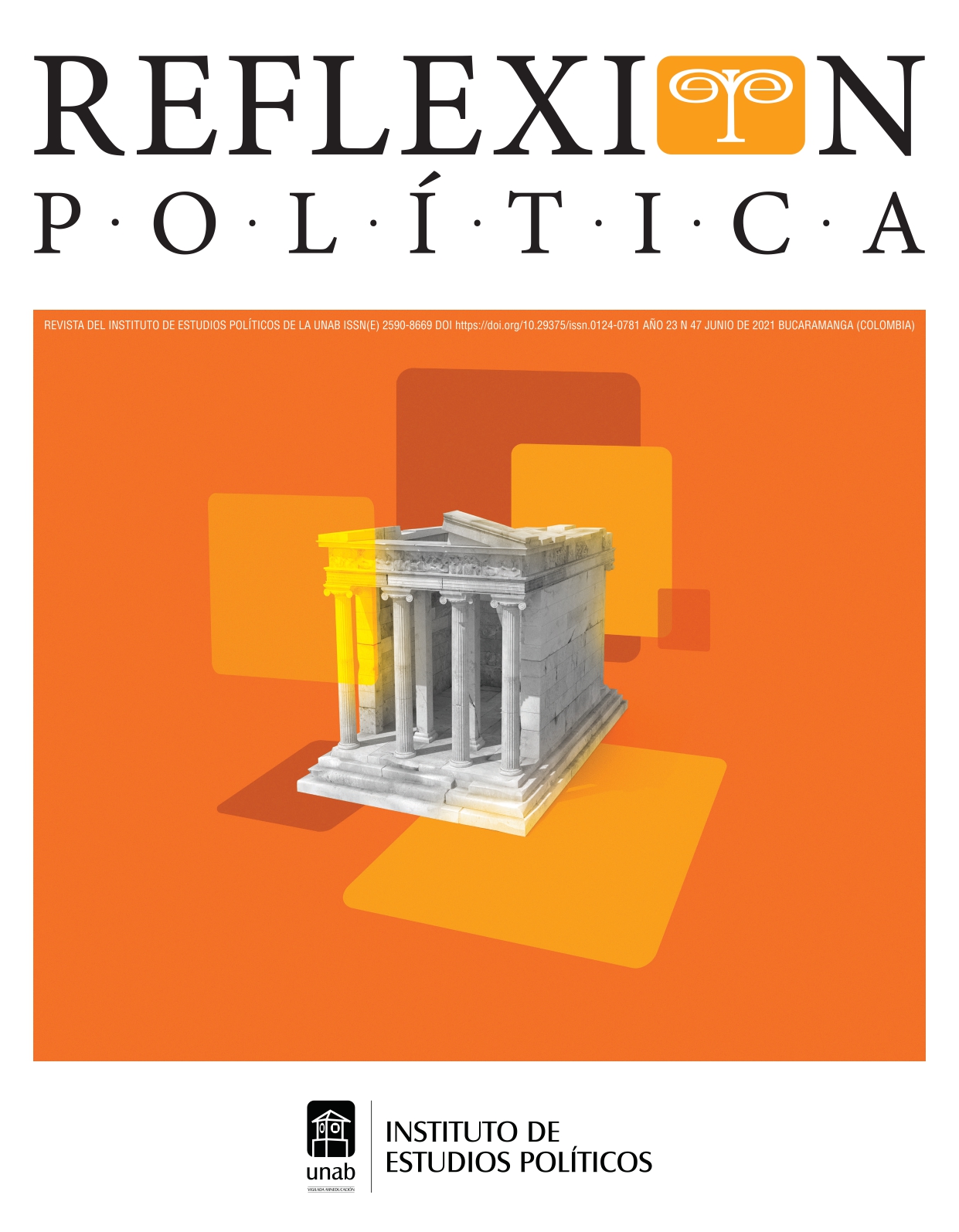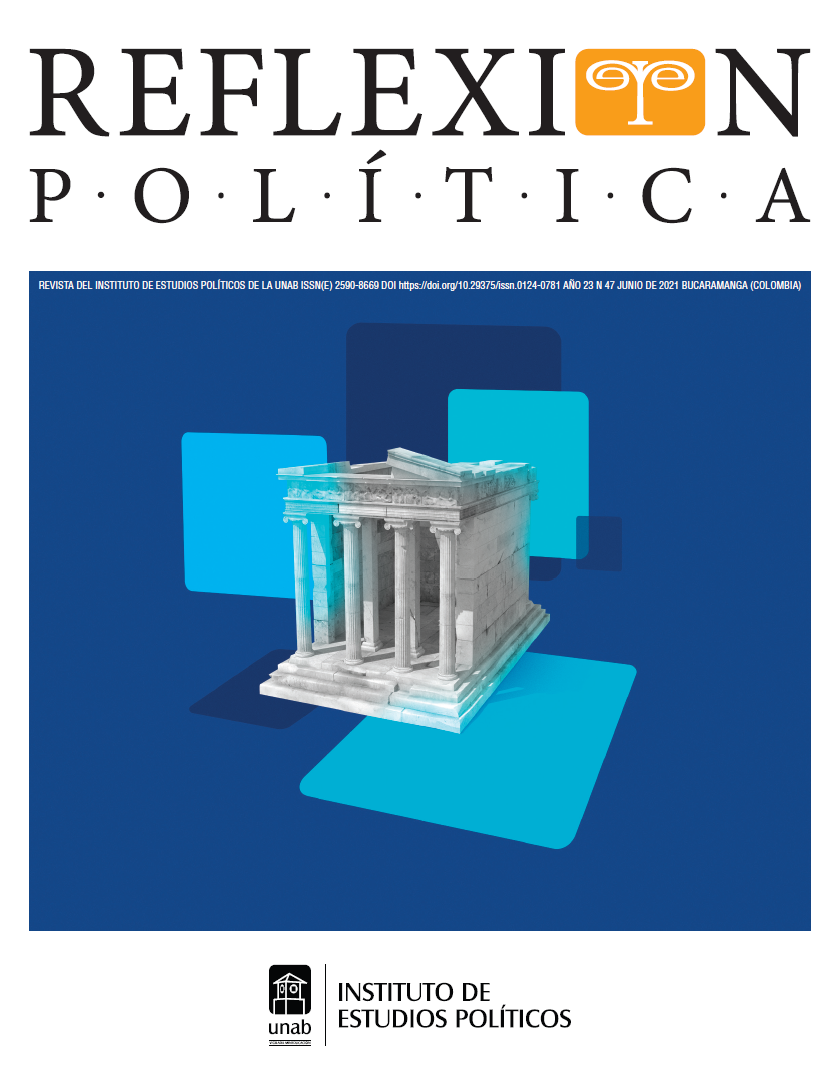Estado de la investigación sobre el crecimiento verde desde la perspectiva de política pública 2011 – 2021
Resumen
Desde los inicios de la apuesta multilateral por el crecimiento verde, se han generado un sinnúmero de políticas locales, de carácter nacional, para dar respuesta a esta demanda mundial. Al mismo tiempo, ha crecido el interés de investigar y profundizar sobre la implementación y evaluación de los programas derivados de los compromisos internacionales. El objetivo de este trabajo es presentar un análisis comprensivo sobre el estado de la investigación respecto al crecimiento verde y la política pública en la última década (2011-2021). Se encuentra que la mayor parte de la producción académica se da en Europa y Asia, y los tópicos con mayor interés son los condicionantes de la efectividad de la política pública, los direccionamientos en tecnología e innovación, la inversión, la evaluación de la política y la discusión conceptual sobre la que se soporta la política. El artículo muestra el debate sobre estos asuntos.
Referencias bibliográficas
Aguilar Galeano, E., & Figueroa Espinel, J. F. (2018). La Política Pública Distrital de Ruralidad de Bogotá D.C., Implementación de una política ambiental en el marco del desarrollo humano. Editorial Uniagustiniana. https://doi.org/10.28970/9789585498167
Bagheri, M., Guevara, Z., Alikarami, M., Kennedy, C. A., & Doluweera, G. (2018). Green growth planning: A multi-factor energy input-output analysis of the Canadian economy. Energy Economics, 74, 708-720. https://doi.org/10.1016/J.ENECO.2018.07.015
Banerjee, O., Bagstad, K. J., Cicowiez, M., Dudek, S., Horridge, M., Alavalapati, J. R. R., Masozera, M., Rukundo, E., & Rutebuka, E. (2020). Economic, land use, and ecosystem services impacts of Rwanda’s Green Growth Strategy: An application of the IEEM+ESM platform. Science of the Total Environment, 729, 138779. https://doi.org/10.1016/j.scitotenv.2020.138779
Baran, B. (2015). Support for renewable energy in Germany as an example of effective public policy. Oeconomia Copernicana, 6(2), 143-158. https://doi.org/10.12775/OEC.2015.017
Bassi, A. (2016). Moving Towards Integrated Policy Formulation and Evaluation: The Green Economy Model. Environmental and Climate Technologies, 16(1), 5-19. https://doi.org/10.1515/rtuect-2015-0009
Béfort , N. (2020). Going beyond definitions to understand tensions within the bioeconomy: The contribution of sociotechnical regimes to contested fields. Technological Forecasting and Social Change, 153, 119923. https://doi.org/10.1016/j.techfore.2020.119923
Béfort, N., & Nieddu, M. (2020). Bioéconomie : un retour historique sur deux problématisations de l’usage des ressources renouvelables. Natures Sciences Sociétés, 28(3-4), 216-225. https://doi.org/10.1051/NSS/2021011
Bentsen, N. S., Larsen, S., & Stupak, I. (2019). Sustainability governance of the Danish bioeconomy - The case of bioenergy and biomaterials from agriculture. Energy, Sustainability and Society, 9(1), 1-14. https://doi.org/10.1186/S13705-019-0222-3/TABLES/1
Bouzaher, A., Sahin, S., & Yeldan, E. (2015). How to green: a general equilibrium investigation of environmental policies for sustained growth with an application to Turkey’s economy. Letters in Spatial and Resource Sciences, 8(1), 49-76. https://doi.org/10.1007/S12076-014-0124-0/TABLES/4
Bruckman, V. J., Haruthaithanasan, M., Miller, R. O., Terada, T., Brenner, A. K., Kraxner, F., & Flaspohler, D. (2018). Sustainable Forest Bioenergy Development Strategies in Indochina: Collaborative Effort to Establish Regional Policies. Forests 2018, 9(4), 223. https://doi.org/10.3390/F9040223
Burkolter, P., & Perch, L. (2014). Greening growth in the south: Practice, policies and new frontiers. South African Journal of International Affairs, 21(2), 235-259. https://doi.org/10.1080/10220461.2014.941917
Caplan, A. J., & Go, D. H. (2020). Measuring the bioeconomic impacts of prolonged drought on a lake ecosystem: The case of the Great Salt Lake, Utah. Natural Resource Modeling, 33(2). https://doi.org/10.1111/NRM.12251
Chomkhamsri, K., Mungcharoen, T., & Yuvaniyama, C. (2016). 10-year experience with the Thai national LCI database: case study of 'refinery products. The International Journal of Life Cycle Assessment, 22(11), 1760-1770. https://doi.org/10.1007/S11367-016-1160-3
Costa, J., Kot, S., & Stefko, R. (2021). Carrots or Sticks: Which Policies Matter the Most in Sustainable Resource Management? Resources, 10(2), 12. https://doi.org/10.3390/resources10020012
Dauda, L., Long, X., Mensah, C. N., Salman, M., Boamah, K. B., Ampon-Wireko, S., & Kofi Dogbe, C. S. (2021). Innovation, trade openness and CO2 emissions in selected countries in Africa. Journal of Cleaner Production, 281, 125143. https://doi.org/10.1016/j.jclepro.2020.125143
Guo, L. ling, Qu, Y., Wu, C. you, & Wang, X. ling. (2018). "Identifying a pathway towards green growth of Chinese industrial regions based on a system dynamics approach". Resources, Conservation and Recycling, 128, 143-154. https://doi.org/10.1016/J.RESCONREC.2016.09.035
Haberl, H., Wiedenhofer, D., Virág, D., Kalt, G., Plank, B., Brockway, P., Fishman, T., Hausknost, D., Krausmann, F., Leon-Gruchalski, B., Mayer, A., Pichler, M., Schaffartzik, A., Sousa, T., Streeck, J., & Creutzig, F. (2020). A systematic review of the evidence on decoupling of GDP, resource use and GHG emissions, part II: synthesizing the insights. Environmental Research Letters, 15(6), 065003. https://doi.org/10.1088/1748-9326/AB842A
Hickel, J., & Kallis, G. (2019). Is Green Growth Possible?. New Political Economy , 25(4), 469-486. https://doi.org/10.1080/13563467.2019.1598964
Islam, M., & Managi, S. (2019). Green growth and pro-environmental behavior: Sustainable resource management using natural capital accounting in India. Resources, Conservation and Recycling, 145, 126-138. https://doi.org/10.1016/j.resconrec.2019.02.027
Ivanova, Y. (2017). The Green Economy model: A promise or a reality for the Latin-American countries?. International Politics Reviews, 5, 13-20. https://doi.org/10.1057/s41312-017-0021-9
Jakob, M., & Edenhofer, O. (2014). Green growth, degrowth, and the commons. Oxford Review of Economic Policy, 30(3), 447–468. https://doi.org/10.1093/oxrep/gru026.
Jasinevičius, G., Lindner, M., Verkerk, P. J., & Aleinikovas, M. (2017). Assessing Impacts of Wood Utilisation Scenarios for a Lithuanian Bioeconomy: Impacts on Carbon in Forests and Harvested Wood Products and on the Socio-Economic Performance of the Forest-Based Sector. Forests 2017, 8(4), 133. https://doi.org/10.3390/F8040133
Kang, M. J., & Park, H. (2011). Impact of experience on government policy toward acceptance of hydrogen fuel cell vehicles in Korea. Energy Policy, 39(6), 3465-3475. https://doi.org/10.1016/J.ENPOL.2011.03.045
Kelleher, L., Henchion, M., & O’Neill, E. (2019). Policy coherence and the transition to a bioeconomy: The case of Ireland. Sustainability (Switzerland), 11(24). https://doi.org/10.3390/SU11247247
Kröger, M., & Raitio, K. (2017). Finnish forest policy in the era of bioeconomy: A pathway to sustainability? Forest Policy and Economics, 77, 6-15. https://doi.org/10.1016/J.FORPOL.2016.12.003
Leitão, J., Pereira, D., & de Brito, S. (2020). Inbound and Outbound Practices of Open Innovation and Eco-Innovation: Contrasting Bioeconomy and Non-Bioeconomy Firms. Journal of Open Innovation: Technology, Market, and Complexity 2020, 6(4), 145. https://doi.org/10.3390/JOITMC6040145
Li, W., & Li, D. (2012). Environmental information transparency and implications for green growth in China. Public Administration and Development, 32(3), 324-334. https://doi.org/10.1002/PAD.1626
Marvik, O. J., & Philp, J. (2020). The systemic challenge of the bioeconomy: A policy framework for transitioning towards a sustainable carbon cycle economy. EMBO Reports, 21(10). https://doi.org/10.15252/EMBR.202051478
Mathews, J. A. (2015). Energizing Industrial Development: The Role of the State in 21st Century Greening Strategies. Revista Do Serviço Público, 66, 29–54. https://doi.org/10.21874/RSP.V66I0.1276
Monasterolo, I., & Raberto, M. (2019). The impact of phasing out fossil fuel subsidies on the low-carbon transition. Energy Policy, 124, 355-370. https://doi.org/10.1016/J.ENPOL.2018.08.051
Monasterolo, I., Raberto, M., Monasterolo, I., & Raberto, M. (2018). The EIRIN Flow-of-funds Behavioural Model of Green Fiscal Policies and Green Sovereign Bonds. Ecological Economics, 144(C), 228-243. https://doi.org/10.1016/J.ECOLECON.2017.07.029
Moosmann, D., Majer, S., Ugarte, S., Ladu, L., Wurster, S., & Thrän, D. (2020). Strengths and gaps of the EU frameworks for the sustainability assessment of bio-based products and bioenergy. Energ Sustain Soc, 10(22), 2-19. https://doi.org/10.1186/s13705-020-00251-8
Mukhtarov, F., Gerlak, A., & Pierce, R. (2017). Away from fossil-fuels and toward a bioeconomy: Knowledge versatility for public policy? Environment and Planning C: Politics and Space, 35(6), 1010-1028. https://doi.org/10.1177/0263774X16676273
Muza, O., & Debnath, R. (2021). Disruptive innovation for inclusive renewable policy in sub-Saharan Africa: A social shaping of technology analysis of appliance uptake in Rwanda. Renewable Energy, 168, 896-912. https://doi.org/10.1016/j.renene.2020.12.091
Özbuğday, F. C., Fındık, D., Metin Özcan, K., & Başçı, S. (2020). Resource efficiency investments and firm performance: Evidence from European SMEs. Journal of Cleaner Production, 252, 119824. https://doi.org/10.1016/j.jclepro.2019.119824
Palgan, Y. V., & McCormick, K. (2016). Biorefineries in Sweden: Perspectives on the opportunities, challenges and future. Biofuels, Bioproducts and Biorefining, 10(5), 523-533. https://doi.org/10.1002/BBB.1672
Pandey, P. C. (2020). Circular Designing and Green Growth: Insights on Future of Sustainability. SAGE Journals, 24(1), 113-117. https://doi.org/10.1177/0972262920903904
Pannell, D. J., Tillie, P., Rodríguez-Cerezo, E., Ervin, D., & Frisvold, G. B. (2016). Herbicide resistance : economic and environmental challenges. AgBioForum, 19(2), 136-155. https://mospace.umsystem.edu/xmlui/handle/10355/59578
Park, J. (2011). The Evolution of Green Growth Policy: An Unwelcome Intrusion on Global Environmental Governance? Journal of East Asian Economic Integration, 17(2), 207-241. https://dx.doi.org/10.11644/KIEP.JEAI.2013.17.2.264
Petig, E., Choi, H. S., Angenendt, E., Kremer, P., Grethe, H., & Bahrs, E. (2019). Downscaling of agricultural market impacts under bioeconomy development to the regional and the farm level—An example of Baden-Wuerttemberg. GCB Bioenergy, 11(10), 1102-1124. https://doi.org/10.1111/GCBB.12639
Philippidis, G., Bartelings, H., Helming, J., M’barek, R., Smeets, E., & van Meijl, H. (2019). Levelling the playing field for EU biomass usage. Economic Systems Research, 31(2), 158-177. https://doi.org/10.1080/09535314.2018.1564020/SUPPL_FILE/CESR_A_1564020_SM1227.DOCX
Philippidis, G., M’Barek, R., & Ferrari, E. (2016). Is “bio-based” activity a panacea for sustainable competitive growth? Energies, 9(10). https://doi.org/10.3390/en9100806
Philp, J. (2015). Balancing the bioeconomy: Supporting biofuels and bio-based materials in public policy. Energy and Environmental Science, 8(11), 3063-3068. https://doi.org/10.1039/c5ee01864a
Pitkänen, K., Antikainen, R., Droste, N., Loiseau, E., Saikku, L., Aissani, L., Hansjürgens, B., Kuikman, P. J., Leskinen, P., & Thomsen, M. (2016). What can be learned from practical cases of green economy? –studies from five European countries. Journal of Cleaner Production, 139, 666-676. https://doi.org/10.1016/J.JCLEPRO.2016.08.071
Purkus, A., & Lüdtke, J. (2020). A systemic evaluation framework for a multi-actor, forest-based bioeconomy governance process: The German Charter for Wood 2.0 as a case study. Forest Policy and Economics, 113, 102113. https://doi.org/10.1016/J.FORPOL.2020.102113
Quenault, B. (2020). Energy transition and the sustainability of development trajectories: Are we headed toward a mere marginal adjustment or a disruptive transformation? Mondes En Developpement, 192(4), 45-70. https://doi.org/10.3917/MED.192.0045
Rampasso, I. S., Quelhas, O. L. G., Anholon, R., Silva, D. A. L., Pontes, A. T., Miranda, J. D. A., & Dias, J. O. (2021). The Bioeconomy in emerging economies: a study of the critical success factors based on Life Cycle Assessment and Delphi and Fuzzy-Delphi methods. The International Journal of Life Cycle Assessment 2021, 26(6), 1254-1266. https://doi.org/10.1007/S11367-021-01913-1
Sampaio Neto, O. Z., Batista, E. A. C., & Meirelles, A. J. de A. (2020). Potencial de oleaginosas nativas no desenvolvimento de cadeias produtivas da biodiversidade brasileira. Desenvolvimento e Meio Ambiente, 54(0), 537-559. https://doi.org/10.5380/DMA.V54I0.71934
Seidl, I., & Zahrnt, A. (2015). Social welfare politics cannot ignore growthmania. Undefined, 24(4), 232-235. https://doi.org/10.14512/GAIA.24.4.6
Smith, E., & Diggans, J. (2020). Next Steps to Grow the Bioeconomy. Health Security, 18(4), 297-302. https://doi.org/10.1089/HS.2020.0012
Söderholm, K., Bergquist, A. K., & Söderholm, P. (2017). The transition to chlorine free pulp revisited: Nordic heterogeneity in environmental regulation and R&D collaboration. Journal of Cleaner Production, 165, 1328-1339. https://doi.org/10.1016/J.JCLEPRO.2017.07.190
Stahel, W. R. (2017). Analysis of the structure and values of the European Commission’s Circular Economy Package. Proceedings of Institution of Civil Engineers: Waste and Resource Management, 170(1), 41-44. https://doi.org/10.1680/jwarm.17.00009
Teigiserova, D. A., Hamelin, L., & Thomsen, M. (2020). Towards transparent valorization of food surplus, waste and loss: Clarifying definitions, food waste hierarchy, and role in the circular economy. Science of The Total Environment, 706, 136033. https://doi.org/10.1016/J.SCITOTENV.2019.136033
Toivonen, R., Vihemäki, H., & Toppinen, A. (2021). Policy narratives on wooden multi-storey construction and implications for technology innovation system governance. Forest Policy and Economics, 125, 102409. https://doi.org/10.1016/J.FORPOL.2021.102409
Tong, C., Ding, S., Wang, B., & Yang, S. (2020). Assessing the target-availability of China’s investments for green growth using time series prediction. Physica A: Statistical Mechanics and Its Applications, 537, 122724. https://doi.org/10.1016/j.physa.2019.122724
Vazquez-Brust, D. A., & Sarkis, J. (2012). Green growth: Managing the transition to a sustainable economy: Learning by doing in East Asia and Europe. Springer. https://doi.org/10.1007/978-94-007-4417-2
Venkata Mohan, S., Dahiya, S., Amulya, K., Katakojwala, R., & Vanitha, T. K. (2019). Can circular bioeconomy be fueled by waste biorefineries - A closer look. Bioresource Technology Reports, 7, 100277. https://doi.org/10.1016/J.BITEB.2019.100277
Wang, X., & Shao, Q. (2019). Non-linear effects of heterogeneous environmental regulations on green growth in G20 countries: Evidence from panel threshold regression. Science of the Total Environment, 660, 1346-1354. https://doi.org/10.1016/J.SCITOTENV.2019.01.094
Wang, Y., Hu, H., Dai, W., & Burns, K. (2021). Evaluation of industrial green development and industrial green competitiveness: Evidence from Chinese urban agglomerations. Ecological Indicators, 124, 107371. https://doi.org/10.1016/j.ecolind.2021.107371
Zhou, Z., Wu, H., & Song, P. (2019). Measuring the resource and environmental efficiency of industrial water consumption in China: A non-radial directional distance function. Journal of Cleaner Production, 240, 118169. https://doi.org/10.1016/j.jclepro.2019.118169
Descargas
Derechos de autor 2023 Reflexión Política

Esta obra está bajo una licencia internacional Creative Commons Atribución-NoComercial-SinDerivadas 4.0.
| Estadísticas de artículo | |
|---|---|
| Vistas de resúmenes | |
| Vistas de PDF | |
| Descargas de PDF | |
| Vistas de HTML | |
| Otras vistas | |





















